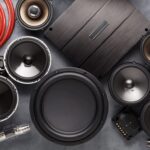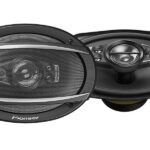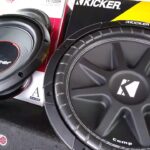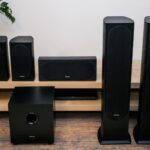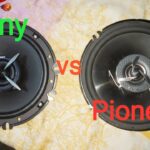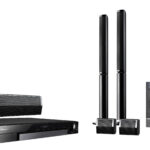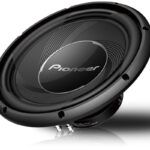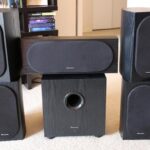The JBL 306P MkII and Yamaha HS7 are both popular studio monitors with powerful sound and accurate reproduction. We will compare the two models to help you make an informed decision about which one is the best choice for your needs.
We will discuss their key features, performance, and price to provide a comprehensive overview of their strengths and weaknesses. Whether you are a musician, producer, or audio enthusiast, finding the right studio monitor is crucial for achieving the best sound quality in your recordings and mixes.
So let’s dive in and see how these two models stack up against each other.
Jbl 306P Mkii Vs Yamaha Hs7 : A Comparison Of Key Features And Performance
When it comes to professional studio monitors, two top contenders in the market are the Jbl 306P Mkii and the Yamaha Hs7. Both of these models are highly regarded and have gained popularity among audio producers and enthusiasts. In this article, we will explore and compare the key features and performance of these two models to help you make an informed decision.

Introduction to Jbl 306P Mkii
The Jbl 306P Mkii is a compact and powerful studio monitor that offers exceptional audio quality. It features a 6.5-inch woofer and a 1-inch tweeter, delivering a frequency response of 47Hz to 20kHz. The Jbl 306P Mkii is known for its accurate sound reproduction and detailed imaging, making it ideal for critical listening and precise mixing.
Introduction to Yamaha Hs7
The Yamaha Hs7 is another well-regarded studio monitor that has been praised for its transparent and flat sound reproduction. It features a 6.5-inch woofer and a 1-inch tweeter, providing a frequency response of 43Hz to 30kHz. With its balanced and accurate sound signature, the Yamaha Hs7 is a popular choice among audio professionals and music producers.
Explanation of the Jbl 306P Mkii and Yamaha Hs7 models’ key features and specifications
Let’s delve deeper into the key features and specifications of both the Jbl 306P Mkii and the Yamaha Hs7:
| Feature | Jbl 306P Mkii | Yamaha Hs7 |
|---|---|---|
| Woofer Size | 6.5-inch | 6.5-inch |
| Tweeter Size | 1-inch | 1-inch |
| Frequency Response | 47Hz – 20kHz | 43Hz – 30kHz |
| Maximum SPL | 110 dB | 106 dB |
| Amplifier Power | 112W | 95W |
| Input Connectors | XLR, TRS, RCA | XLR, TRS |
| Room Control | Yes | Yes |
| High Trim | Yes | Yes |
Comparison of the frequency response and sound quality of Jbl 306P Mkii and Yamaha Hs7
One of the most important aspects to consider when choosing studio monitors is their frequency response and sound quality. Both the Jbl 306P Mkii and Yamaha Hs7 offer impressive performance in these areas, but there are some notable differences.
The Jbl 306P Mkii has a frequency response range of 47Hz to 20kHz, providing a balanced representation of low, mid, and high frequencies. This ensures that you can hear every detail in your audio recordings, making it easier to achieve accurate and precise mixing.
The Yamaha Hs7, on the other hand, has a wider frequency response range of 43Hz to 30kHz. This extended range allows for a more detailed and nuanced sound reproduction, especially in the higher frequency spectrum. This can be particularly beneficial for producers working with genres that rely heavily on high-frequency content, such as electronic music or vocals.
In terms of sound quality, both the Jbl 306P Mkii and Yamaha Hs7 deliver exceptional accuracy and transparency. They are designed to provide a flat response, meaning that they don’t artificially enhance or color the sound. This allows you to make unbiased judgments when mixing and ensures that your audio will translate well across different playback systems.
Ultimately, the choice between the Jbl 306P Mkii and Yamaha Hs7 depends on your specific needs and preferences. If you prioritize a wider frequency response range and detailed high-frequency reproduction, the Yamaha Hs7 may be the better option for you. However, if you value a well-balanced frequency response and precise imaging, the Jbl 306P Mkii is a solid choice.
Now that you have a better understanding of the key features and performance of the Jbl 306P Mkii and Yamaha Hs7, you can make an informed decision based on your individual requirements. Both of these models offer excellent sound quality and are trusted by professionals in the audio industry.
Jbl 306P Mkii
In the world of studio monitors, the Jbl 306P Mkii has made a name for itself for its exceptional performance and innovative features. If you’re a music producer or an audio engineer, you understand the importance of accurate and detailed sound reproduction. The Jbl 306P Mkii has been designed with these needs in mind, providing a professional-grade monitoring solution that doesn’t break the bank. Let’s dive deeper into the Jbl 306P Mkii and explore its key features and performance factors.
Overview of the Jbl 306P Mkii
The Jbl 306P Mkii is a compact two-way studio monitor that boasts cutting-edge technology and premium components. Powered by a class-D amplifier, this monitor delivers 112dB of peak output with a frequency range of 47Hz to 20kHz. The 6.5-inch woofer and 1-inch tweeter work together flawlessly to provide a balanced and accurate sound representation.
Design and build quality of the Jbl 306P Mkii
When it comes to design and build quality, the Jbl 306P Mkii doesn’t disappoint. It features a sleek and modern look with a matte black finish that blends seamlessly into any studio environment. The cabinet is made of reinforced MDF, which enhances durability and reduces unwanted resonance. The front-mounted port ensures optimal bass performance, allowing you to experience deep and punchy lows. The control panel, located on the rear of the monitor, offers adjustable input sensitivity and boundary EQ settings, empowering you to tailor the sound to your specific space.
Sound performance and frequency response of the Jbl 306P Mkii
The sound performance of the Jbl 306P Mkii is truly impressive. Its balanced frequency response ensures that you hear every detail in your mix, making it an invaluable tool for critical listening and accurate audio production. The monitor delivers rich bass, clear mids, and detailed highs, allowing you to make informed decisions when it comes to mixing and mastering. With its wide sweet spot, the Jbl 306P Mkii provides consistent sound quality regardless of your listening position, ensuring a reliable and accurate monitoring experience.
In terms of frequency response, the Jbl 306P Mkii covers a wide range from 47Hz to 20kHz, allowing you to hear the full spectrum of your audio content. The tight and controlled bass response adds depth and impact to your tracks, while the detailed treble reproduction brings out the nuances and shimmer in high-frequency elements. Whether you’re producing EDM, rock, classical, or any other genre, the Jbl 306P Mkii has you covered with its accurate and transparent sound reproduction.
In conclusion, the Jbl 306P Mkii is a top-notch studio monitor that offers outstanding sound performance, durable build quality, and a user-friendly design. Its wide frequency response and precise audio reproduction make it an excellent choice for both professional and amateur music producers. If you’re looking for an affordable and high-performing studio monitor, the Jbl 306P Mkii should definitely be on your radar.
Yamaha Hs7
The Yamaha Hs7 is a highly acclaimed studio monitor that has become a popular choice among audio professionals and enthusiasts alike. With its exceptional sound performance, sleek design, and sturdy build quality, the Hs7 is often considered a benchmark in the industry.
Overview of the Yamaha Hs7
The Yamaha Hs7 is a two-way, bass-reflex powered monitor speaker that is designed to deliver accurate and detailed sound reproduction. It features a 6.5-inch cone woofer and a 1-inch dome tweeter, which work together to provide a wide frequency range and smooth response across the entire audio spectrum. The Hs7 is equipped with a 95-watt bi-amplification system, ensuring ample power for a loud and clear sound output.
Design and Build Quality of the Yamaha Hs7
The Yamaha Hs7 boasts a clean and minimalist design that complements any studio setup. It features a sturdy MDF enclosure with a sleek black finish, giving it a professional and premium look. The front baffle is elegantly curved to reduce diffraction, ensuring precise and accurate sound reproduction. The monitor also comes with a removable grille, allowing users to customize the appearance and protection of the speaker.
Furthermore, the Hs7 is built to last, with high-quality components and excellent craftsmanship. The monitor is designed to minimize resonance and unwanted vibrations, resulting in a distortion-free listening experience. Its solid construction ensures durability, making it a reliable choice for long hours of studio use.
Sound Performance and Frequency Response of the Yamaha Hs7
The Yamaha Hs7 is revered for its exceptional sound quality and accurate frequency response. The monitor delivers a well-balanced and transparent sound, allowing users to hear every nuance in their audio recordings. The 6.5-inch woofer produces tight and punchy bass, while the 1-inch tweeter delivers crisp and articulate highs. The Hs7 provides a flat frequency response, making it an ideal choice for audio professionals who require uncolored and unbiased monitoring.
Moreover, the Hs7 offers a wide sweet spot, meaning listeners can experience consistent sound quality even when moving around the room. This is achieved through Yamaha’s advanced waveguide technology, which helps to control the dispersion of sound and enhance the stereo imaging.
In conclusion, the Yamaha Hs7 is a studio monitor that excels in design, build quality, and sound performance. Its accurate reproduction and exceptional clarity make it a reliable tool for audio professionals and music enthusiasts alike. Whether you are mixing, mastering, or simply enjoying music, the Yamaha Hs7 delivers an immersive listening experience that is hard to rival.

Jbl 306P Mkii Vs Yamaha Hs7: Design And Build Quality
When it comes to choosing professional studio monitors for your home or professional studio, it’s important to consider the design and build quality. The design and build of a monitor can greatly impact its performance and overall durability. In this comparison, we will take a closer look at the Jbl 306P Mkii and Yamaha Hs7 monitors to see how they stack up in terms of aesthetics, physical appearance, materials used, as well as durability and stability.
Aesthetics and Physical Appearance of the Jbl 306P Mkii and Yamaha Hs7
The aesthetics of a monitor can play a significant role, especially if you value a sleek and stylish look in your studio setup. Both the Jbl 306P Mkii and Yamaha Hs7 offer a visually appealing design, but with some notable differences.
The Jbl 306P Mkii features a modern and clean design, with a matte black finish that gives it a professional and understated appearance. The front baffle is slightly angled for better sound projection, providing a visually dynamic look to the monitor. The Jbl logo is prominently displayed on the front, adding a touch of branding to the overall design.
On the other hand, the Yamaha Hs7 boasts a more classic and retro-inspired design. With its iconic white cone and black enclosure, the Yamaha Hs7 gives off a vintage vibe while still maintaining a timeless look. The Yamaha logo is discreetly placed on the front, blending seamlessly into the overall design.
Materials Used in the Construction of the Jbl 306P Mkii and Yamaha Hs7
When it comes to the construction of studio monitors, the choice of materials plays a crucial role in ensuring accurate sound reproduction and overall durability.
The Jbl 306P Mkii is crafted with a high-quality MDF (Medium-Density Fiberboard) enclosure, which helps to reduce unwanted resonance and vibrations. The front baffle is reinforced with a metal plate, providing additional rigidity to the monitor. The result is a sturdy and solid construction that enhances the monitor’s performance.
Similarly, the Yamaha Hs7 also features an MDF enclosure, ensuring a robust and rigid structure. To further enhance its acoustic performance, the Hs7 utilizes a unique Damped Resonance Control technology, which helps to minimize vibrations and deliver a cleaner and more accurate sound.
Durability and Stability of Both Models
When investing in studio monitors, durability and stability are important factors to consider, as they can directly impact the lifespan and overall performance of the monitors.
The Jbl 306P Mkii is designed with reliability in mind, featuring reinforced edges and a sturdy construction that can withstand the rigors of daily use. Its rubberized feet ensure stability on various surfaces, while also minimizing vibrations that could affect the monitor’s performance.
The Yamaha Hs7 is also built to last, with a solid construction that can handle the demands of professional use. Its extensive internal bracing helps to reduce cabinet resonance and enhance durability. The monitor comes with built-in mounting points for wall or ceiling installation, providing additional stability options.
In conclusion, both the Jbl 306P Mkii and Yamaha Hs7 excel in terms of design, build quality, and durability. The Jbl 306P Mkii offers a modern and sleek appearance, while the Yamaha Hs7 boasts a classic and timeless design. Both models utilize high-quality materials and are built to withstand the demands of professional use. Whichever monitor you choose, you can be confident in its aesthetics, performance, and longevity.
Jbl 306P Mkii Vs Yamaha Hs7: Sound Quality
When it comes to choosing the perfect studio monitors for your mixing and mastering needs, sound quality is of utmost importance. The Jbl 306P Mkii and Yamaha Hs7 are two highly acclaimed options that have garnered a loyal following amongst audio professionals. Let’s take a closer look at the sound quality of both models and how they compare in terms of frequency response range, precision and accuracy, as well as bass and low-end performance.
Frequency Response Range of Both Models
The frequency response range of a studio monitor is crucial for capturing every detail and nuance of your audio. The Jbl 306P Mkii boasts an impressive frequency response range of 47Hz – 20kHz, allowing for accurate reproduction of both lows and highs. On the other hand, the Yamaha Hs7 offers a slightly wider range, spanning from 43Hz – 30kHz. This expanded range provides the ability to capture even more intricate details in the audio spectrum, especially in the higher frequencies.
Precision and Accuracy of Sound Reproduction
When it comes to precision and accuracy in sound reproduction, both the Jbl 306P Mkii and Yamaha Hs7 excel. Each model is meticulously designed to minimize distortion and deliver a transparent and neutral sound signature. The Jbl 306P Mkii utilizes its patented Image Control Waveguide technology to ensure precise imaging and accurate soundstage. Meanwhile, the Yamaha Hs7 features a unique Biamplified design that combines a dedicated amplifier for the woofer and tweeter, allowing for optimal control and precision in sound reproduction.
Bass Response and Low-End Performance Comparison
Powerful and defined bass reproduction is essential for mixing and mastering tasks. The Jbl 306P Mkii provides a robust and tight bass response, thanks to its 6.5-inch woofer and built-in dual integrated Class-D amplifiers. With a frequency range that extends down to 47Hz, the Jbl 306P Mkii offers a solid foundation for your mixes. Similarly, the Yamaha Hs7 with its 6.7-inch woofer delivers impressive low-end performance, reaching down to 43Hz. The bass response of both models is accurate and well-defined, allowing you to make precise decisions when sculpting your mix.
Mid and High-Range Performance in Jbl 306P Mkii and Yamaha Hs7
When it comes to the mid and high-range performance, the Jbl 306P Mkii and Yamaha Hs7 both shine. The Jbl 306P Mkii offers a balanced and detailed mid-range, providing clarity and separation in vocals and instruments. Its high-frequency reproduction is crisp and accurate, allowing for precise monitoring of transient details and reverberations. The Yamaha Hs7, on the other hand, delivers a smooth and transparent mid-range, ensuring every subtlety in your audio is faithfully reproduced. Its high-frequency response is exceptionally detailed, enabling you to hear every shimmer and sparkle in your mix.
In conclusion, both the Jbl 306P Mkii and Yamaha Hs7 offer exceptional sound quality with their own strengths in various aspects. Whether you prioritize a wider frequency response range or precise mid and high-range performance, both models deliver professional-grade sound reproduction that will elevate your mixing and mastering endeavors.
Jbl 306P Mkii Vs Yamaha Hs7: Connectivity Options And Controls
When it comes to choosing the right studio monitors for your audio production needs, two popular options that often come up are the Jbl 306P Mkii and the Yamaha Hs7. Both of these monitors are highly regarded in the industry for their exceptional sound quality and performance. In this section, we will delve into the connectivity options and control features offered by these two models, allowing you to make an informed decision based on your specific requirements.
Inputs and outputs available in Jbl 306P Mkii and Yamaha Hs7
Having the right inputs and outputs on your studio monitors is crucial for seamless connectivity with your audio devices. Let’s take a closer look at what the Jbl 306P Mkii and the Yamaha Hs7 have to offer:
| Model | Inputs | Outputs |
|---|---|---|
| Jbl 306P Mkii |
|
None |
| Yamaha Hs7 |
|
|
Both the Jbl 306P Mkii and the Yamaha Hs7 offer a range of inputs that provide flexibility when connecting to different audio sources. While the Jbl 306P Mkii lacks outputs, the Yamaha Hs7 offers an additional unbalanced RCA output, allowing you to conveniently connect a subwoofer or an external audio recording device.
Control options and adjustments in both models
Having control over your studio monitors’ settings and adjustments is essential for achieving the desired sound accuracy. Here’s a breakdown of the control options and adjustments available in the Jbl 306P Mkii and the Yamaha Hs7:
- Jbl 306P Mkii:
- Volume control
- High-frequency adjustment (+2dB, 0dB, -2dB)
- Low-frequency adjustment (+2dB, 0dB, -2dB)
- Boundary EQ settings (Free, Desk, Wall)
- Yamaha Hs7:
- Room control settings (High Trim, Mid EQ, Low Trim)
- High trim switch (+2dB, 0dB, -2dB)
- Mid EQ switch (+2dB, 0dB, -2dB)
- Low trim switch (+2dB, 0dB, -2dB)
Both models offer various control options and adjustments that allow you to fine-tune the sound according to your listening environment and personal preferences. Whether you prefer the boundary EQ settings provided by the Jbl 306P Mkii or the room control settings offered by the Yamaha Hs7, you have the flexibility to optimize your listening experience.
Accessibility and ease of use in the Jbl 306P Mkii and Yamaha Hs7
Accessibility and ease of use are crucial factors when it comes to selecting studio monitors. Let’s see how the Jbl 306P Mkii and the Yamaha Hs7 fare in this aspect:
- Jbl 306P Mkii:
- Front-panel volume control for quick adjustments
- Clearly labeled control options for easy navigation
- Yamaha Hs7:
- Rear panel control options for a clean aesthetic
- Ergonomic design for hassle-free access
The Jbl 306P Mkii and the Yamaha Hs7 are both designed with accessibility in mind. The front-panel volume control of the Jbl 306P Mkii allows for easy adjustment, while the Yamaha Hs7’s rear panel control options provide a clean aesthetic. Regardless of your preference for front or rear control access, both models ensure user-friendly operation.
In conclusion, the Jbl 306P Mkii and the Yamaha Hs7 offer excellent connectivity options and control features. Whether you prioritize specific inputs and outputs, require extensive control options, or value ease of use, these two models have you covered. Consider your specific needs and preferences to make the best choice for your audio production setup.
Jbl 306P Mkii Vs Yamaha Hs7: Price And Value For Money
When it comes to choosing the right studio monitors for your music production or mixing needs, the price and value for money are important factors to consider. In this article, we will compare two popular models – the Jbl 306P Mkii and Yamaha Hs7 – and assess their pricing and overall value for money.
Price comparison between Jbl 306P Mkii and Yamaha Hs7
Let’s start by comparing the prices of these two models. The Jbl 306P Mkii is priced at $249 per monitor, while the Yamaha Hs7 comes in at $299 per monitor. This means that the Jbl model is slightly more affordable than the Yamaha.
However, it’s important to note that the pricing alone should not be the sole determinant in your decision. You should evaluate the features, performance, and overall quality of the speakers before making a final judgment.
Assessment of the overall value for money in both models
Now, let’s assess the value for money offered by both the Jbl 306P Mkii and Yamaha Hs7.
Jbl 306P Mkii:
- Frequency response range of 39Hz – 24kHz, providing a wide range of sound reproduction capabilities.
- Class-D amplification delivers powerful and accurate audio performance.
- Image Control Waveguide technology ensures precise imaging and a wide soundstage.
- Integrated Boundary EQ compensates for low-frequency boost when speakers are placed near walls for a more accurate sound.
Yamaha Hs7:
- Frequency response range of 43Hz – 30kHz, offering a detailed and extended frequency range.
- Bi-amp design with a dedicated amplifier for the woofer and tweeter, resulting in improved accuracy and clarity.
- Room Control and High Trim features allow for adjusting the sound to suit different acoustic environments.
- Enclosure design reduces unwanted resonance and delivers a more accurate sound reproduction.
Both models have their own set of impressive features that contribute to their overall value for money. The Jbl 306P Mkii offers a broader frequency range and advanced waveguide technology, while the Yamaha Hs7 provides adjustable sound controls and a bi-amp design.
Factors to consider when deciding between the Jbl 306P Mkii and Yamaha Hs7
When it comes to making a decision between these two models, there are a few factors worth considering:
- Sound preference: Listen to both models and determine which sound signature appeals to you. Do you prefer a more neutral and accurate sound reproduction, or do you lean towards a sound with a bit of warmth?
- Room size: Take into account the size of your studio or workspace. The Jbl 306P Mkii might be a better fit for smaller rooms, while the Yamaha Hs7 could be more suitable for larger spaces.
- Availability of adjustment options: Consider whether you require the flexibility of adjusting the sound characteristics based on your room’s acoustics. The Yamaha Hs7 offers more control options in this aspect.
By considering these factors and weighing them against your specific needs and budget, you will be able to make an informed decision between the Jbl 306P Mkii and Yamaha Hs7.
Conclusion
To sum up, both the JBL 306P MkII and the Yamaha HS7 are excellent choices for anyone looking to upgrade their home studio setup. While the JBL offers a more accurate sound reproduction and a wider frequency response, the Yamaha provides a more balanced and natural sound.
Ultimately, the decision boils down to personal preference and specific audio requirements. Consider your budget, room size, and the type of music you produce before making your final choice. Both monitors offer great value for money and will undoubtedly enhance your audio production experience.
Frequently Asked Questions
What Are The Key Features Of The Jbl 306P Mkii And Yamaha Hs7?
The JBL 306P MkII and Yamaha HS7 both boast powerful sound reproduction, accurate frequency response, and professional-grade components. The JBL 306P MkII offers a robust low-frequency response, while the Yamaha HS7 excels in midrange clarity. Both monitors are equipped with advanced tuning options and sleek designs.
Which Monitor Is Better For Bass-Heavy Music, The Jbl 306P Mkii Or Yamaha Hs7?
If you’re into bass-heavy music, the JBL 306P MkII is the way to go. With its impressive low-frequency response, it delivers booming bass and a satisfying thump in your tracks. The Yamaha HS7 is also capable of reproducing bass accurately but doesn’t quite match the thump and power of the JBL 306P MkII.
Are Jbl 306P Mkii And Yamaha Hs7 Suitable For Professional Studio Use?
Absolutely! Both the JBL 306P MkII and Yamaha HS7 are excellent choices for professional studio setups. They provide accurate sound reproduction, allowing engineers and producers to make precise adjustments and achieve the desired mix. With their high-quality components and renowned reputations, these monitors are trusted by professionals in the industry.
